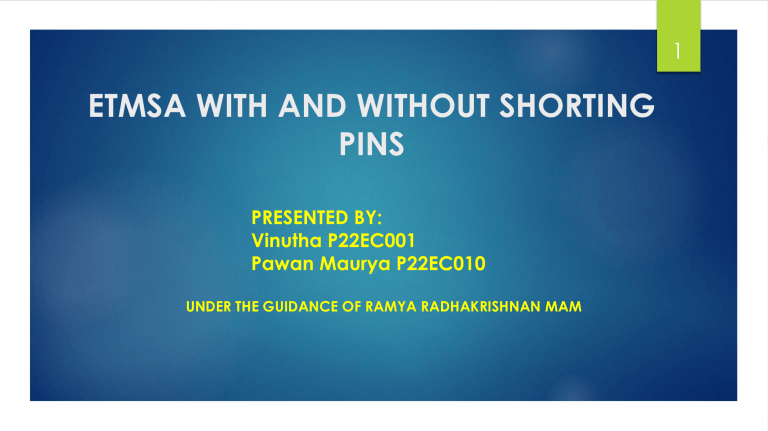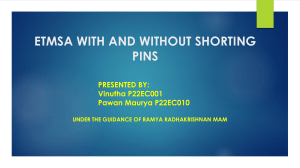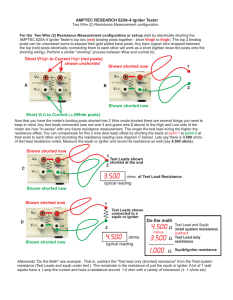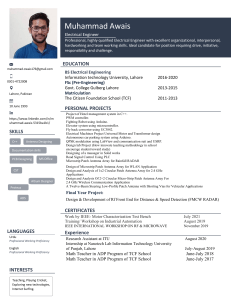
1 ETMSA WITH AND WITHOUT SHORTING PINS PRESENTED BY: Vinutha P22EC001 Pawan Maurya P22EC010 UNDER THE GUIDANCE OF RAMYA RADHAKRISHNAN MAM 2 AIM OF THE PROJECT ► ETMSA WITHOUT SHORTING PINS ► SHORTED 60 SECTOR ► COMPLIMENT OF SHORTED 60 SECTOR 3 INTRODUCTION ► Microstrip antenna is printed antenna. Most popular MSA is Patch antenna. ► If the shape of the patch is equilateral triangle, then it is known as EQUILATERAL TRIANGULAR PATCH ANTENNA.(ETMSA). ► Patch Antenna Contains Ground(Metal),Substrate(dielectric),Patch(metal). 4 INTRODUCTION ❑ Ground plane is not etched out. ❑ Substrate between patch and ground plays an important role in the design since it decides the bandwidth as well as the size of microstrip antenna. ❑ If dielectric constant increases, it decreases Bandwidth, increases Q factor, decreases impedance bandwidth. 5 SUBSTRATES ❑ Arlon/Duroid- Used(epsilon=2.5) ▪ Loss tangent is small ▪ Cost is very high. ❑ Alumina ❑ Glass epoxy ❑ Foam 6 ETMSA ❑ Triangular microstrip antenna is used commonly in wireless communication. ❑ It has omnidirectional radiation pattern. 7 DESIGN ❑ Resonant frequency of the triangular patch antenna is ❑ Where Se is Electrical length of the radiating side and S is the physical length of radiating side. 8 EXPLANATION ❖ Feed is given in central axis to make it symmetrical. ❖ This is not completely symmetrical, Hence cross polar component is more. ❖ 0 field point is at centroid. 9 Shorting Pins ❑ Shorting pins are used to achieve various performance characteristics of microstrip patch Antennas. ❑ Appropriately placing shorting pins can be used to tune the resonant frequencies of the triangular patch antenna. ❑ Using shorting pin reduces patch size and this technique is used to obtain larger bandwidth. 10 ETMSA WITHOUT SHORTING PIN GROUND SUBSTRATE PATCH 11 ETMSA WITHOUT SHORTING PIN INNER AND OUTER CONDUCTORS 12 ETMSA WITHOUT SHORTING PIN FEED FINAL SET UP ETMSA WITHOUT SHORTING PIN S PARAMETER 13 ETMSA WITHOUT SHORTING PIN SMITH CHART 14 ETMSA WITHOUT SHORTING PIN VSWR v/s FREQUENCY 15 ETMSA WITHOUT SHORTING PIN POLAR PLOT 16 ETMSA WITHOUT SHORTING PIN RADIATION PATTERN 17 18 ETMSA WITH SHORTED 60 SECTOR 19 ETMSA WITH SHORTED 60 SECTOR ETMSA WITH SHORTED 60 SECTOR S PARAMETER 20 ETMSA WITH SHORTED 60 SECTOR SMITH CHART 21 ETMSA WITH SHORTED 60 SECTOR VSWR V/S FREQUENCY 22 ETMSA WITH SHORTED 60 SECTOR RADIATION PATTERN 23 ETMSA WITH SHORTED 60 SECTOR POLAR PLOT 24 ETMSA WITH SHORTED COMPLIMENTED 60 SECTOR 25 ETMSA WITH SHORTED COMPLIMENTED 60 SECTOR 26 ETMSA WITH SHORTED COMPLIMENTED 60 SECTOR S PARAMETER 27 ETMSA WITH SHORTED COMPLIMENTED 60 SECTOR SMITH CHART 28 ETMSA WITH SHORTED COMPLIMENTED 60 SECTOR VSWR v/s FREQUENCY 29 ETMSA WITH SHORTED COMPLIMENTED 60 SECTOR RADIATION PATTERN 30 ETMSA WITH SHORTED COMPLIMENTED 60 SECTOR POLAR PLOT 31 32 OBSERVATION TABLE Patch type fo(GHz) S11(dB) VSWR B.W (MHz) Impedance Matching(Oh m) Area(cm2) ETMSA without shorting pin TMSA with shorted 60o Sector- 2.99 -27.64 1.102 42 50.57 6.92 3.0157 -26.71 1.148 35.8 50.76 2.78 TMSA with Compliment shorted 60o Sector- 3.077 -25.02 1.152 33.7 50.8 4.14 33 ADVANTAGES ❏ Light weight, Low cost, low profile and conformal. ❏ Easy to fabricate and can be integrated with other microstrip component. ❏ This antenna is compatible with modular design. 34 DISADVANTAGES ❏ Low power handling capacity. ❏ Narrow bandwidth. ❏ Poor isolation between Feed and Radiating element. 35 APPLICATIONS ► Bluetooth ► Wifi ► Cellular 36 CONCLUSION ► Size of antenna is reduced ► Bandwidth Increased. ► Impedance matching is achieved. 37 REFERENCES Antenna, Prof.Girish kumar Youtube videos Dual-band circularly polarized equilateral triangular-patch array antenna for mobile satellite communications. December 2005 IEEE Transactions on Antennas and Propagation 53(11):3477 - 3485 DOI:1 0.1109/TAP.2005.858849 Source IEEE Xplore Project: Antennas for Satellite Communication 38 THANK YOU!!



